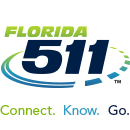|
|
|
|
I-4 Ultimate Landscaping Efforts Kick Off
|
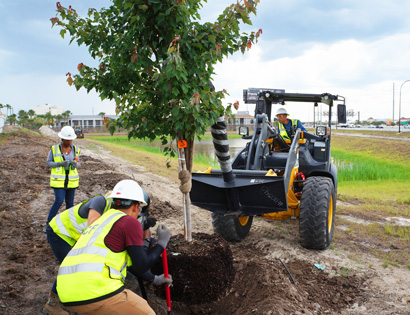
|
I-4 Ultimate crews dug deep through the dirt, not for roadway construction, but rather to plant the project’s first tree.
The planting of the 11-foot-tall tree and its 20 identical neighbors signified the beginning of the carefully planned and gradual landscaping efforts along the 21-mile project limits.
The trees were planted in late May on the Caravan Court side of the new Grand National Drive overpass near the Interstate 4 (I-4)/Kirkman Road (State Road 435) interchange. Crews planted trees here first because the overpass construction is slated to complete soon, and the roadway will carry motorists as soon as this fall.
More than $28 million of the I-4 Ultimate project’s budget will be spent on planting about 14,500 canopy and flowering trees, 4,400 palms, 10,625 buffer shrubs and 60,200 smaller shrubs and groundcovers. Additionally, nearly one million square feet of irrigation will be installed to maintain the landscape.
Brett Nein, ASLA, the principal landscape architect with Jacobs, is excited about the opportunity to highlight the Sunshine State’s natural beauty by using native and non-invasive Florida-friendly plants.
“These plants are best adapted to local climate conditions and soils,” Nein said. “In turn, that limits the routine maintenance required and it increases the chances of survival to a well-established and mature growth.”
There are some unique considerations when designing and implementing the project’s landscaping, given its scope and size.
“If the entire project had to be installed at one time, there would not be enough materials available in the state with the proper size and species to complete the task,” Nein said. “There’s a process where several nurseries and growers are preparing plants for delivery at prescribed heights and quantities well in advance corresponding with the project phasing.”
The thematic design will feel and look consistent throughout the corridor. The interchanges may have a varying level of landscaping features depending on the area available. In each case, the plant life will be blended with the waterside and drainage areas and the bridge and lighting aesthetics features to create the most functional and visually appealing landscape.
As the project continues and finishes in 2021, the plants — much like the ones recently planted — will grow to become just as a much part of the fabric of Central Florida as the new interstate itself.
For additional information on I-4 Ultimate landscaping and natural beautification efforts, visit fdot.tips/I4Lndscp.
|
|
|
Maitland Pedestrian Bridge Construction Begins
|
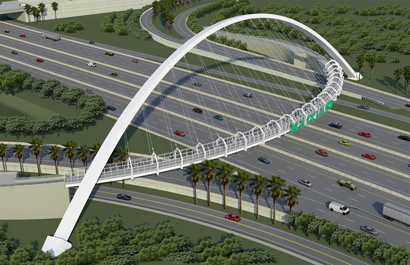
|
Work is underway on the Maitland pedestrian bridge – a specially designed structure that will stretch across 10 lanes of the reconstructed Interstate 4 (I-4).
With its 625-foot-long curving walkway and 142-foot-high arches, the bridge was designed to have an architectural flair and act as a signature gateway for a vibrant community. It is also one of several improvements for pedestrians and bicyclists within the I-4 Ultimate project.
Built in conjunction with the new interchange at I-4 and Maitland Boulevard (State Road 414), the bridge will connect sidewalks at Lake Destiny and Wymore roads. The construction team will build both sides of the bridge simultaneously so the arches meet at their highest points and the two halves of the curving walkway line up perfectly.
As each half is about the length of a football field, a tiny miscalculation can create huge problems. The engineering and design also must take into account the expansion and contraction of materials in the extreme heat of Florida days.
However, those helping to manage the construction said the outcome will be worth the effort. “It’s going to be a fun process to watch,” said Jack Leider, the I-4 Ultimate Project Manager for Area 4, which includes Maitland.
Construction will require pile driving to create strong foundations for the arches. Many of the steel piles will be driven into the ground (at least, part of the way) using the quieter vibration method. That will minimize the use of the more powerful hammers, which are held above the pilings by cranes. Sounds and vibrations will be measured to make sure they stay within acceptable limits.
Ultimately, the walkway will be suspended over the interstate without the usual supporting piers in the middle. But during construction, crews will use temporary shoring towers to secure the bridge.
Bill Eskins, a Construction Manager for SGL – the construction joint venture of Skanska, Granite, Lane – called it an exciting challenge. “I think this is going to be the best-looking pedestrian bridge in the state of Florida,” Eskins said.
|
|
|
Two New I-4 Ramps Open this Month
|
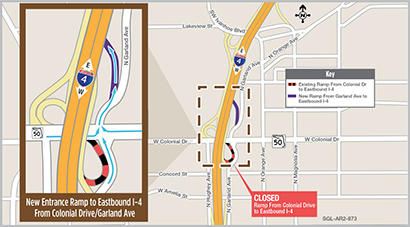
|
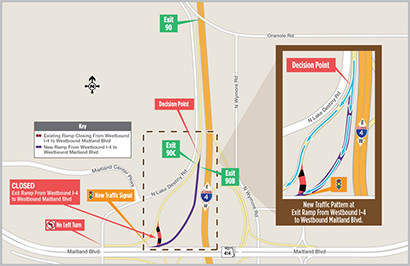 |
Two new Interstate 4 (I-4) ramps opened earlier this month as they shifted to more permanent locations to improve traffic flow and open new construction areas for the I-4 Ultimate project.
Motorists began using the new entrance ramp to eastbound I-4 from Garland Avenue on June 15. The new ramp replaced the loop ramp from eastbound Colonial Drive (State Road 50). Unlike the old ramp that only served eastbound Colonial Drive, the new ramp provides access to eastbound I-4 from Garland Avenue and both directions of Colonial Drive. An illustration of the new ramp is available online at fdot.tips/SR50.
A new westbound Interstate 4 (I-4) exit ramp to westbound Maitland Boulevard (State Road 414) opened on June 9. Motorists exit westbound I-4 from the same location; however, the decision to exit left toward westbound Maitland Boulevard or right toward northbound Lake Destiny Road is made approximately 1,700 feet sooner. An illustration of the new ramp is available online at fdot.tips/SR414.
Near the end of the ramp to westbound Maitland Boulevard, motorists cross over the future westbound Maitland Boulevard. A traffic signal at the end of the ramp allows motorists to safely continue on to the current westbound Maitland Boulevard. Later this year, the new westbound Maitland Boulevard travel lanes will open, and this exit ramp will continuously flow onto Maitland Boulevard without a traffic signal.
|
|
|
Massive Concrete Pour Builds Flyover Piers
|
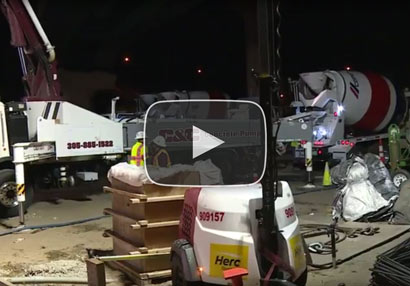
|
If there was any doubt why the Interstate 4 (I-4) improvement project is called the “Ultimate,” maybe the 100 or so concrete truck trips on the night of May 19 can help drive home the point.
One of the largest continuous concrete pours for the I-4 Ultimate project took place that night as nearly 900-cubic-yards of concrete were pumped into the foundation substructure for two flyover piers at the I-4/State Road (S.R.) 408 interchange. The two piers are some of the tallest at the interchange. One pier is 92-feet-tall and the other 60-feet-tall and they will support flyover ramps from eastbound I-4 to westbound S.R. 408 and eastbound S.R. 408 to westbound I-4.
Two concrete pump trucks with long boom arms and a team of more than a dozen construction workers filled the foundation substructure at a rate of about 120 cubic yards of concrete per hour. Each pump truck was continuously fed concrete from two mixer trucks.
Division Avenue under S.R. 408 was closed for the night to accommodate the queue of concrete trucks and ensure there was no break in the supply of concrete to the pumper trucks. The concrete order was so large that two nearby plants were required to meet the need.
Equally impressive is the foundation substructure. Nearly 200,000 tons of steel rebar were used to construct the structure. While a team of SGL crew members — the construction joint venture of Skanska, Granite and Lane — built the foundation substructure in about two weeks and filled it with concrete in just seven hours, the massive foundation can take several weeks to cure.
To learn more about the redesigned I-4/S.R. 408 interchange, visit i4ultimate.com/future408.
|
|
|
SGL Receives National Honor for its Helping Hands
|
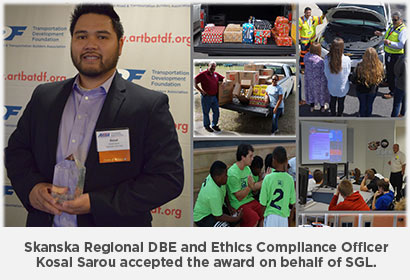
|
The I-4 Ultimate construction team was honored recently with a national Helping Hand award for their community service in Central Florida.
SGL – the construction joint partnership of Skanska, Granite and Lane – earned a Helping Hand Honorable Mention Award in Washington, D.C. The award was given by the American Road & Transportation Builders Association and the Transportation Development Foundation.
“SGL is very proud of our Corporate Community Investment (CCI) initiatives. CCI is a core component of this project and our overall governing values,” said Russ Handler, who is the SGL Communications Coordinator. “Our community outreach efforts help address social challenges while also integrating our team into the local communities and we are very pleased that these efforts continue to expand each year.”
Other community service and charitable activities include educational outreach and participation in programs and events to stimulate interest in the fields of science, technology, engineering and math. SGL also sponsors an annual Angel Tree Program which provides holiday gifts to needy kids throughout the project limits.
In addition, SGL conducts various food pantry and school supply drives throughout the year.
|
|
|
Spotlight Employee: Chris Copeland
Chris Copeland
Core Competency Training Program
Resides: Maitland
|
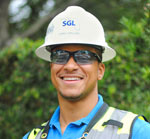
“It’s good because you learn so much.” |
|
|
Chris Copeland is learning multiple sides of civil engineering through each rotation of the Skanska Core Competency Training Program (CCTP) — one of several on-the-job training programs offered by Skanska.
The Skanska CCTP includes several rotations with SGL, the I-4 Ultimate joint venture partnership of Skanska, Granite and Lane. They include estimating, field engineering, environmental health and safety, project controls, assistant superintendent, and a “wild card” assignment among others. Copeland is currently in the environmental health and safety rotation.
Despite the fast pace, he enjoys the challenge. “It’s good because you learn so much,” he said. “You get to network and meet new people.”
In high school, Copeland took technical drawing and computer-aided design and drafting classes. But he said he was always a fan of Legos and building things. He got the idea of becoming a civil engineer from his older brother, who also wanted to be one. He chose to go to Virginia Military Institute because they offered civil engineering and a full athletic scholarship in football. “I kind of knew what I wanted to do, and I just made it happen,” he said.
Before joining the I-4 Ultimate project, Copeland worked at the Skanska office in Virginia Beach and started out as an estimator for the Pensacola Bay Bridge project. He wanted to be a part of the I-4 Ultimate project because of its scale. “I was excited when they said that I get to come here for a long period of time,” Copeland said. “I knew it was going to be a pretty significant project for us. Just from the size of it and that they want it to be a signature corridor.”
|
|
|
|
|
|
|
Public participation is solicited without regard to race, color, national origin, age, sex, religion, disability or family status. Persons who require special accommodations under the Americans with Disabilities Act or persons who require translation services (free of charge) should contact Jennifer Smith, FDOT Title VI Coordinator by phone at (386) 943-5367, or via email at jennifer.smith2@dot.state.fl.us. If you are hearing or speech impaired, please contact us by using the Florida Relay Service, 1-800-955-8771 (TDD) or 1-800-955-8770 (Voice).
|








